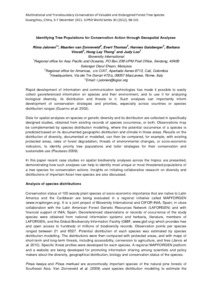Identifying tree populations for conservation action through geospatial analyses
Rapid development of information and communication technologies has made it possible to easily collect georeferenced information on species and their environment, and to use it for analyzing biological diversity, its distribution and threats to it. Such analyses can importantly inform development of conservation strategies and priorities, especially across countries or species distribution ranges (Guarino et al. 2002). Data for spatial analyses on species or genetic diversity and its distribution are collected in specifically designed studies, obtained from existing records of species occurrence, or both. Observations may be complemented by species distribution modelling, where the potential occurrence of a species is predicted based on its documented geographic distribution and climate in those areas. Results on the distribution of diversity, documented or modelled, can then be compared, for example, with existing protected areas, rates of forest degradation, threats of environmental changes, or socio-economic indicators, to identify priority tree populations and tailor strategies for their conservation and sustainable use (Pautasso 2009). In this paper recent case studies on spatial biodiversity analyses across the tropics are presented, demonstrating how such analyses can help to identify most unique or most threatened populations of a tree species for conservation actions. Insights on initiating collaborative research on diversity and distributions of important Asian tree species are also discussed.

